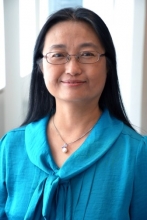CEE Seminar (ZOOM): Recent Advances in Electrodialysis for Water Reuse, Desalination and Concentrate Treatment

Endowed Professor
Civil Engineering Department
New Mexico State University
Abstract: Electrodialysis uses ion-exchange membranes (IEMs) to separate salt ions in water under an electrical field. Electrodialysis has a high tolerance of silica, hardness, chlorine residual and organic matter; therefore, it could achieve higher water recovery and lower costs than reverse osmosis (RO) during impaired water treatment. Another unique advantage of electrodialysis is the selective separation of monovalent ions (such as Na+, K+, NH4+, Cl- and NO3-) versus multivalent ions (e.g., Ca2+, Mg2+, SO42- and PO43-). Selective removal of Na+ over Ca2+ and Mg2+ is especially important if the treated water is used for irrigation. This study presents the advances in developing innovative, nanocomposite IEMs to enhance monovalent permselectivity, reduce membrane organic fouling and biofouling, and improve energy efficiency. Bench and pilot-scale experiments were conducted to evaluate the desalination performance during the treatment of wastewater, brackish water and RO concentrate. Polymer-modified membranes demonstrated the Na-selectivity up to nine times better than the unmodified membranes. Membrane fouling, in particular biofouling, was significantly reduced by membrane coating with hybrid conductive polymers and nanomaterials such as titanium dioxide (TiO2) and graphene oxide (GO). GO coating significantly improved the desalination efficiency of both cation and anion exchange membranes during wastewater treatment. The study demonstrated the bench-scale testing results could be used to simulate and project desalination performance and ion selectivity of the pilot- and full-scale electrodialysis applications.
Bio: Pei Xu is a professor in the Department of Civil Engineering at the New Mexico State University, and the research director of the New Mexico Produced Water Research Consortium. She leads basic and applied research on water quality, water reuse, membrane processes, photocatalysis, resources recovery from wastewater, and renewable energy-powered water treatment and desalination systems. The goal of her research is to address critical water challenges using non-traditional water supplies such as brackish water, produced water, desalination concentrate and municipal wastewater. She was selected as a Leshner Fellow on Food and Water Security by the American Association for the Advancement of Science (AAAS), PESCO Endowed Professorship and C. Herb Ward Family Endowed Interdisciplinary Chair at NMSU.
